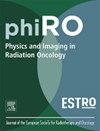Dose calculation accuracy of clinical radiotherapy plans using next generation cone beam computed tomography imaging technology
IF 3.3
Q2 ONCOLOGY
引用次数: 0
Abstract
Background and purpose
Next generation cone beam computed tomography (CBCT) technology has shown improved Hounsfield unit accuracy over standard CBCT, and comparable to that of fan beam CT simulators (CTsim), potentially allowing direct dose calculation on CBCT. In this study, we evaluated the dose calculation accuracy of clinical treatment plans calculated using this technology, compared with standard CBCT.
Materials and methods
Thirty subjects with thoracic or upper abdominal cancer were imaged on CTsim, standard CBCT and next generation CBCT, and treated using breath hold techniques. Both CBCT image sets were rigidly registered to CTsim, and clinical treatment plans were forward calculated on all images. 3D Gamma analysis was used to evaluate CBCT dose distributions relative to CTsim, and DVH analysis compared PTV and OAR dose metrics.
Results
The median (±IQR) 3 %/3 mm gamma pass rate was 96.7 ± 3.1 % for next generation CBCT and 93.3 ± 14.0 % for standard CBCT. Next generation CBCT gamma scores were statistically significantly higher than standard CBCT for all gamma criteria. Median DVH metrics were within ± 2.3 % and ± 2.7 % of the corresponding values from CTsim, for next generation and standard CBCT respectively. Standard CBCT showed an underestimation of ipsilateral lung dose for breast subjects, while next generation CBCT did not.
Conclusions
Next generation CBCT allows for good average DVH agreement with CTsim, and improved dose calculation accuracy over standard CBCT across 3D dose distributions. While further clinical investigations are warranted, this technology may allow for the use of CBCT in direct-dose calculation in adaptive radiotherapy.
新一代锥束计算机断层成像技术应用于临床放疗方案剂量计算的准确性
背景和目的下一代锥束计算机断层扫描(CBCT)技术比标准CBCT显示出更高的Hounsfield单位精度,与扇束CT模拟器(CTsim)相当,可能允许在CBCT上直接计算剂量。在本研究中,我们评估了使用该技术计算的临床治疗方案的剂量计算准确性,并与标准CBCT进行了比较。材料与方法对30例胸部或上腹部肿瘤患者进行CTsim、标准CBCT和下一代CBCT成像,并采用屏气技术进行治疗。将两组CBCT图像严格配准到CTsim中,并在所有图像上向前计算临床治疗方案。3D Gamma分析用于评估CBCT相对于CTsim的剂量分布,DVH分析用于比较PTV和OAR剂量指标。结果新一代CBCT的中位(±IQR) 3% / 3mm伽马通过率为96.7±3.1%,标准CBCT为93.3±14.0%。下一代CBCT伽玛评分在所有伽玛标准上均显著高于标准CBCT。对于下一代CBCT和标准CBCT,中位DVH指标分别在CTsim相应值的±2.3%和±2.7%范围内。标准CBCT显示乳房受试者的同侧肺剂量低估,而下一代CBCT则没有。结论新一代CBCT的平均DVH与CTsim的一致性较好,并且在三维剂量分布上比标准CBCT的剂量计算精度更高。虽然需要进一步的临床研究,但该技术可能允许在适应性放疗中使用CBCT直接计算剂量。
本文章由计算机程序翻译,如有差异,请以英文原文为准。
求助全文
约1分钟内获得全文
求助全文
来源期刊

Physics and Imaging in Radiation Oncology
Physics and Astronomy-Radiation
CiteScore
5.30
自引率
18.90%
发文量
93
审稿时长
6 weeks
 求助内容:
求助内容: 应助结果提醒方式:
应助结果提醒方式:


